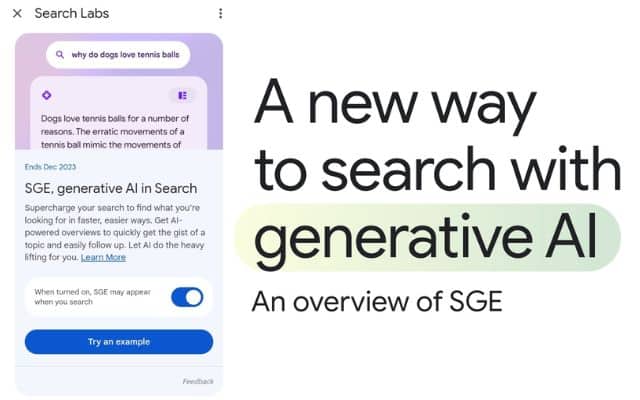
Discover the future of web search with Google Search Generative Experience – Search Generative Experience. Explore AI-driven insights, conversational searches, and more. Stay ahead with the latest in online search technology.
At the Google I/O event on May 10, 2023, Google formally announced its new search generative experience (SGE) after months of Project Magi rumours.
Google is counting on AI to revolutionise search. However, it goes beyond chatbots.
Although it is now working on a chatbot project named Bard, the well-known search engine isn’t solely focused on chatbots. It involves more than simply redesigning the homepage to seem like ChatGPT’s messaging platform.
Instead, Google is making its existing search results, the most lucrative area of the internet, the centre of its AI strategy.
Let’s find out more details about this novel experiment.
Google Search Generative Experience (Google SGE)
A limited beta version of Google’s Search generative experience (SGE) uses massive language models to produce contextual and conversational snapshot solutions to difficult inquiries in search results. The new dynamic and chat-based search engine has been dubbed a “search generative experience” (SGE) by Google. It includes
AI-Driven Visuals:
SGE brings incorporation of AI-generated visuals and offering consumers educational glimpses that give a quick rundown of crucial information and pertinent insights.
Vertical Experiences:
To increase the depth and specificity of search results, SGE develops vertical experiences that appeal to particular topics or niches.
Conversation Mode:
With SGE, users can engage in conversational interactions with the search engine, a departure from the traditional keyword-based queries.
Seamless Follow-Up Questions:
SGE encourages users to ask follow-up questions, fostering a natural and informative dialogue with the AI.
What’s the process behind Google Search Generative Experience (Google SGE)?
You don’t need to open a tonne of tabs to conduct research on any subject because you can talk, obtain AI-powered briefings, and even ask a follow-up question.
SGE uses generative AI to enrich search queries with more context and data in an effort to enhance the search experience. SGE enhances search for the end user by better comprehending topics, gaining fresh insights, and simplifying the process.
Although conversational search is still in its infancy, most people are aware that it may have an impact on how frequently users scroll down to locate organic links or paid content since they already have concise answers to their queries.
AI-Powered Pictures
Although this is not always the case, SGE shows customers an AI-driven snapshot (or “snapshot,” as Google likes to call it) to give them a short rundown of important considerations and a useful overview of pertinent insights and facts.
Users can use these snapshots as a jumping-off point to explore a wide range of content and viewpoints on the web.
Then, SGE will include connections to sources or websites that support the facts in the snapshot, enabling visitors to independently verify the material and go deeper. This includes our blog on content amplification tactics. Users will be able to discover diverse stuff thanks to this.
More Conversational & Personalised SERPs
Do you have any additional queries on any particular subjects?
With Google SGE, you may just ask a follow-up question beneath the photo rather of opening dozens of tabs for each query. Under the snapshot, you have the choice to “Ask a follow-up”.
It will then launch a new “conversation mode,” where you may naturally ask Google SGE more queries about the subject you’re viewing. You can request more connections to the sites you wish to look at in addition to the quick bits of AI-generated info.
For follow-up questions and more complicated or shifting knowledge journeys, the conversational mode performs well. To recognise when a user is looking for anything related to a previous search, it employs artificial intelligence. It rewords the query to better reflect the user’s purpose by using context from earlier inquiries.
Users can easily explore the most pertinent stuff from around the web in conversational mode by viewing their site connections beneath Google SGE as the conversation progresses.
When we inquired further about “affordable air purifier options,” SGE provided us with links to products that had come up during our conversational search. This suggests a fantastic business opportunity.
You could receive more qualified traffic and, obviously, AI-powered pictures if your content is optimised for conversational forms of searches.
Results for Local Packs & Product Searches
Information journeys connected to verticals like retail and local searches benefit from SGE.
It offers pertinent product details and aids in the discovery of insights for difficult purchase selections. Google SGE is based on Google’s Shopping Graph and gives information about nearby locations using AI-powered insights. It produces a list of notable elements and a variety of product possibilities.
Local search is one of the vertical experiences that Google has prioritised. Google SGE will provide information about nearby locations using AI-powered insights that make it simple to compare and explore possibilities, according to Google.
The most intriguing finding in this instance is that the SGE Results display a 5-pack rather than the pre-existing 3-local pack. Each pack result in the 5-pack contains a brief description that occasionally includes reviews.
As can be seen above, SGE’s local business listing results display reviews, photos, and descriptions of the businesses. It is therefore best to maintain optimised listings and maximise your company’s visibility in organic listings.
Sponsored Ads
With Google Search Generative AI, you can quickly and simply discover insights to make judgements when buying. You will see a tonne of distinct product possibilities and a tonne of significant considerations in the snapshots. It will also provide you with product descriptions that include all the details you require, including reviews, ratings, prices, and product photos.
Google SGE is built on Google’s Shopping Graph, which is essentially the largest collection in the world of ever-changing products. Advertisers will still have the opportunity to reach potential clients during their search process with SGE because advertisements will continue to appear in specific ad spots all over the page.
How Does SEO Impact Search Generative Experience?
Users will have to make fewer inquiries to find the information they need because SGE combines data from various sources into a single summary. They are consequently less likely to browse other websites by scrolling down the SERPs.
The search generative experience will likely be the most significant Google algorithm update since BERT and RankBrain. (If it is accessible globally, it is now in beta and only available to Americans.)
What we already know about click-through rates from conventional search could be drastically altered by this update. When it comes to comprehending complex concepts and succinctly summarising crucial points, generative AI has the potential to be a major game-changer.
One-sentence queries and sensitive questions are two categories of questions that AI typically is unable to respond to.
The following searches in SGE do not result in an AI response:
Quick responses include the current weather, the date, or song lyrics.
Typically, AI does not respond to navigational requests involving brand names where the customer only wants a connection to the main website.
- There don’t seem to be any recipes right now.
- sensitive inquiries on the Holocaust, gender identity, etc.
- Finance and health-related questions (YMYL)
- Things occurring “now,” such as recent news and events, are not included.
These are well-liked categories. Even while they make up less than 70% of all searches, it’s easy to think that they make up a sizable amount of Google’s 8.5 billion daily searches.
But if SGE is well deployed, will organic traffic, featured snippets, and PPA become the norm?
About 70% of queries, according to many SEO professionals, do not result in an AI response; this is also what we have seen. Although there is a catch, it is doubtful that search generating experience will hurt your website’s SEO or organic visitors.
However, as illustrated in the GIF about choosing a yoga mat, you can see that there are numerous sources for buying the mat with pricing comparisons & reviews from trustworthy users when you click any specific video.
Various SERP components, such as featured snippets, are still included in the SERP in the beta version of Google SGE. Notably, it has been seen that prominent snippets are positioned very next to AI snippets. Given that they both give a succinct description of the topic, this may seem counterintuitive.
AI cannot be totally trusted, and Google’s AI-driven responses are no exception.
For instance, it advised boiling the eggs for a total of 60 minutes when Cypus Shephard (founder of Zyppy and SEO consultant at Moz) asked about how to boil an egg.
Google hopes to improve the user experience of searching or purchasing with the use of generative AI.
SGE’s photos are solely supported by several blogs and articles. Therefore, if your website has:
- Conversant material
- Comprehensive details on the subject
- Adheres to E-E-A-T standards for YMYL themes.
- So you shouldn’t be concerned that SGE will reduce your organic traffic.
SGE can also be beneficial for e-commerce companies since it teaches customers how to focus their search before they click, which increases the likelihood that they will be higher-intent customers before they even visit your website. In such instance, SGE functions as a salesperson who assists customers in qualifying before they even enter your store.
What is Google Search Generative Experience and how do I get it?
Google SGE is only available in the United States at the moment because it is currently being tested. Only individuals who have registered for Search Labs are able to access SGE.
Here is a Steps for utilising Google’s SGE:
You must first register or add your name to the waitlist for Search Labs. This could take a while.
Do not utilise a Google Workspace account; only a personal Google account should be used.
- Open Search Labs and then enable SGE for browsing and search.
- Utilising search laboratories
- Make sure “Incognito mode” is off and SGE is on while you are signed into your Google Account.
- Start embracing the new era of personalised generative search AI!
How to Activate Google SGE
Use most recent version of Google app or Chrome browser, depending on whether you’re using it on a PC or a mobile device.
Open Google: Launch Google app or open Chrome on your device.
Access Settings: Look for three dots in top right corner of the search bar and click on them.
Go to Settings: From dropdown menu, select “Settings.”
Find Search Labs: Scroll down the settings menu until you locate “Search Labs.”
Activate SGE: There, you’ll see a switch next to “SGE.” Toggle this switch to turn on SGE.
Once you’ve completed these steps, you’re all set to experience the new search interface with SGE’s enhanced features.
The Advantages of SGE
Learn Quicker: With SGE, you may learn more quickly and easily thanks to thorough overviews and interesting multimedia content.
Quick Information Retrieval: SGE’s talent for emphasising relevant results speeds up your search and saves you time.
Engaging Results: Thanks to multimedia integration, your search results become more captivating and help you absorb information more effectively.
Find Out More: Related search suggestions from Google SGE lead to intriguing new data that you might not have thought to look into.
The Future of Search with SGE
Although SGE is currently in the experimental stage, it has the power to fundamentally alter how we conduct information searches. Google SGE meets the rising demand for effective and user-friendly search experiences by concentrating on providing thorough and interesting search results.
If you’re a frequent Google user, don’t hesitate to give Google SGE a try. Even though it’s a new function, it has the potential to make your searches more useful and interesting than before. Watch this space for updates as Google continues to polish this functionality. The search industry is changing, and SGE is setting the pace for this fascinating change.
- How to Resolve Google Play Payment Decline Issues: 8 Solutions
- Top 2023 Google Authenticator Alternatives for Strong Online Security
- How to change time zone on google calendar
- One simple trick to get more informative Google Search results
Conclusion
There’s no need to freak out as more businesses adopt AI, as content competition continues to soar, and as SERPs increasingly rely on AI. In fact, it’s a wonderful chance for all of us to take a step back and consider what we create, where we generate it, and how we can make it better.
Please be aware that SGE is a work-in-progress and that the AI Snapshot triggers may change over time. Therefore, while it might not be necessary right away, optimising for AI search might be worthwhile. The best course of action right now is to join up for Search Labs and Google SGE waitlist. Once you’re on the waitlist, you may verify that a term has received Google SGE treatment if you observe a large shift in the performance of your campaign.






